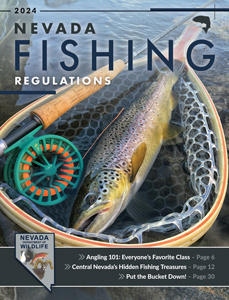Central Nevada’s Hidden Fishing Treasures

By Doug Nielsen
The Silver State is well known for its popular interstate waters and the fishing opportunities they provide. Lake Mead, Lake Mohave, and Lake Tahoe attract anglers from around the world who long to battle with freshwater Striped Bass, Smallmouth Bass, or Lake Trout.
Often overlooked, are the fishing treasures hidden away in some of Nevada’s remote and rugged mountain ranges. Three of those are the Toiyabe, Toquima and Monitor ranges which all run in a north/south direction between U.S. Highways 6 and 50 north and east of Tonopah.
If you are an angler looking for a fishing experience resembling something from a Hollywood fly-fishing movie, you won’t find it here. However, if you are an angler looking for a solitary experience in a wild country away from the bustle and noise of urban environs, this is the place.

Here anglers will find small, and often tree-lined streams cascading down narrow canyons marked by craggy cliffs and sometimes the remnants of pioneer cabins. Originating from high ridges, many of these streams provide anglers with excellent trout fishing opportunities on public lands. Due to the size of their environment, the fish tend to be on the small side, but that does not mean anglers won’t pull out a lunker now and again.
Though some of the streams in these ranges may provide an opportunity to use a back cast, chances are a fisherman won’t need to. Due to their small size, and the vegetation that lines them, a “dapping” technique is probably all one needs to fool a hungry trout.
“Dapping” is one of the oldest fishing techniques, but it should not be overlooked. It is a rather simple technique in which an angler simply dances their bait on the water’s surface. A grasshopper pattern, or even the real thing, danced lightly on the surface can generate some ferocious hits from the fish in these streams.
Red worms – the small kind – or small spinners like a Panther Martin or a Mepp’s can also be productive in skinny water. If you forget to bring worms, do not worry. They can often be found under a dry cow patty.
Neither of these techniques require a special or expensive fishing rod. A basic rod-n-reel combo will work but try to use something on the light side; four-pound test monofilament should serve you well. Anything heavier is unnecessary and could scare a wary fish, and the fish in these small streams will be wary of anything that comes from above them.
Since predators come from above, any movement or shadow will send them into cover. Use the sun and the vegetation to your advantage. Approach a likely-looking spot as quietly as possible and from a direction that prevents your shadow from crossing the water’s surface. Crawling may sometimes be required.
A good pair of polarized sunglasses will help an angler see fish lying on the bottom or in the shadows. They are an essential tool rather than a simple luxury.
Before loading up their gear and pointing their vehicle toward the Toiyabes or any other fishing destination, anglers may want to consult FishNV, NDOW’s online webtool that will help in the trip planning process. All one has to do is type FishNV into the search bar in their internet browser and it will come up. The actual website URL is https://fish.wildlifenv.com.
Once an angler clicks into the app, they can begin searching for all of Nevada’s 533 fishable waters and 32 game fish species. One can search by species, water type, by county, or by NDOW administrative region.
One of the easiest ways to find the fishable streams in the Toiyabes, Toquimas, or the Monitors is to put the cursor in central Nevada and roll your mouse. The streams will be designated in blue. Just click on the blue line and you will find the name and location of that water. Not to mention the trout species that can be found there.
The upper Reese River, for instance, begins in the Arc Dome Wilderness at the Southern end of the Toiyabe Range and holds Brook Trout, Rainbow Trout, and Brown Trout. A little digital scouting ahead of time can save travel time at the fishing end.

